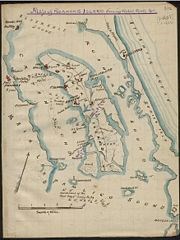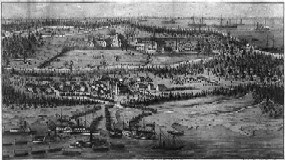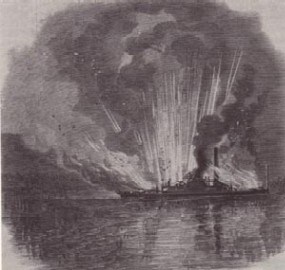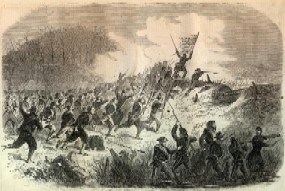|
Few visitors traveling along Route 64 towards Nags Head or touring downtown Manteo’s shops know that they tread upon a battlefield. Little do they realize that, around Roanoke Island, a battle was fought between 20,000 soldiers and sailors and over sixty ships. As an action in the Civil War, it was a small engagement but its repercussions far outweighed its immediate results. 
Library of Congress Union Brigadier General Ambrose Burnside formulated a plan using the Outer Banks as a jumping off point for the invasion of eastern North Carolina. He devised an expedition with troops from New England and the Mid-Atlantic states that were trained and experienced with ocean operations. Various ferryboats, as well, were commandeered because of their shallow draft and their ability to maneuver in the tight waterways. On January 8, 1862, the so called Coastal Division, a motley little fleet of sixty-six ships, put out to sea from Annapolis, Maryland. After a brief stopover at Fort Monroe, Virginia, the expedition headed to Colonel Rush Hawkins’ post at Hatteras Inlet. On January 12th, the fleet, struck by a nor’easter, scattered and many of the smaller ships were almost swamped. The next day, the fleet began to rendezvous at the inlet only to find that some of the ships could not get over the sand bar and into Pamlico Sound, even by lightening their loads. Meanwhile, because of another storm, the City of New York was a total loss with her cargo of ordnance and supplies, the gunboat Zouave was lost, and the Pocahontas sank with most of the horses she was transporting. After three weeks, the remains of the fleet finally assembled in the sound and steamed for Roanoke Island. Because of the loss of ships, the Union was forced to leave behind three regiments at Hatteras Inlet without transportation and the rest were so crowded that many soldiers complained that it was impossible to sleep. 
Library of Congress The fleet arrived off Stumpy Point, North Carolina, where they viewed Roanoke Island for the first time, on February 6, 1862 with sixty ships and 13,000 men. From local escaped slaves, Burnside learned the Confederate strength and layout of their defenses. The eastern or Roanoke sound side was too shallow for most ships so Burnside would have to land on the western side of the island. Confederate defenses were arranged with this in mind. At the top third of the island, the Confederates massed their defensive strength. From Fort Bartow to Fort Forrest, the Confederates had driven piles and sunk eight ships to block the Union Navy’s approach to the rest of the island. Beyond Fort Bartow were Forts Blanchard and Huger and, dominating the only road on the island on a knoll called Supple’s Hill, was a three-gun battery. About 3,000 Confederates from North Carolina and Virginia manned all these installations. Burnside discovered the only favorable landing was south of Fort Bartow on Captain William Ashby’s farm. Besides a relatively protected harbor to land at, Ashby’s was also out of the range of Forts Blanchard and Huger and Fort Bartow’s guns were partially blocked by a slight hill in between. Here, on the next morning, Burnside would make the landing. 
North Carolina Historical Review An intense bombardment of Fort Bartow and the Confederates’ small fleet, derisively called the “Mosquito Fleet”, began around 11:30 a.m. The fleet and fort were punished by the sheer weight of the Union ordinance. The fort, as well as the camp behind it, caught fire and two ships, the Curlew and Forrest, were driven aground near Fort Forrest. In a little under four hours, Confederate resistance was subdued. By nightfall, the Union troops were all ashore and the Confederate hopes were pinned on the small three-gun battery in the center of the island. After suffering through a sleepless rainy night, the Union troops marched out from the landing area at 7:30 a.m. Pushing down the road to the battery, Union soldiers pushed back Confederate skirmishers. Coming around the turn in the road, the Union forces saw their first view of the island’s main defense – the three-gun battery. This battery, sitting astride the road, was thirty-five yards wide with a water-filled ditch eight feet wide and three feet deep guarding the front. Supporting the three guns were about 1,000 poorly armed soldiers from various regiments. The field in front of the battery was seven hundred feet long by three hundred feet wide and surrounded by marshy swamps. It was these pools of black, slimy swampy ground that the Confederates put their faith in. They expected the Union force to funnel their attack down the roadway, as the swamps were too treacherous and impassable. They were proven wrong. 
Harper's Weekly Although the ground was often hard to navigate, units became mixed, the air was filled with smoke from rifle and cannon fire, and the Union troops accidentally fired on each other, the various Union regiments were finally able to effectively attack the three-gun battery. Struck from the front and both ends, the Confederates abandoned the works and fled back to their camps, strewing the road from the battlefield with the equipment that encumbered their flight. Some of the newly arrived Confederate troops attempted to row to Nags Head and safety but many were forced to return. Confederate reinforcements coming from the northern shore of the island met the victorious Union soldiers and were pushed back into the Confederate camps where they were forced to surrender. Roanoke Island was captured by Burnside at a very modest cost in casualties to his men. Official Union losses were given as thirty-seven killed, 214 wounded, and thirteen missing. Confederate losses were only twenty-two killed and fifty-eight wounded. However, 2,500 Confederate soldiers surrendered. The Union, which was still reeling from the Bull Run disaster, garnered much more than just war materiel from this victory. Coupled with the February 15, 1862 victory at Fort Donelson in Tennessee, the Union war effort got a much needed boost; the Union war spirit was reborn with the reduction of Roanoke Island. On a military front, the capture of Roanoke Island opened up the interior riverline port cities, such as Plymouth and New Bern, to direct invasion as well as to threaten Morehead City, North Carolina and Norfolk, Virginia from their weaker rear areas. By the summer of 1862, all of the above cities had fallen to Union forces and seriously threatened the vital rail line from the Confederate capital in Richmond, Virginia to its only east coast blockade running port in Wilmington, North Carolina. With the huge success at Roanoke Island, the Union stranglehold on the South was ever tightening. Though the victory of Roanoke Island may seem small with the passage of time and the historical recountings of major battles like Gettysburg and Vicksburg, this short battle on a tiny island on the Outer Banks may have helped change the tide for the Union war effort. Though there are no battlefields or forts left on the Outer Banks, this battle and the subsequent occupation by the Union Army are important to the history of this area and the people who live here. Credit: |
Last updated: April 14, 2015
